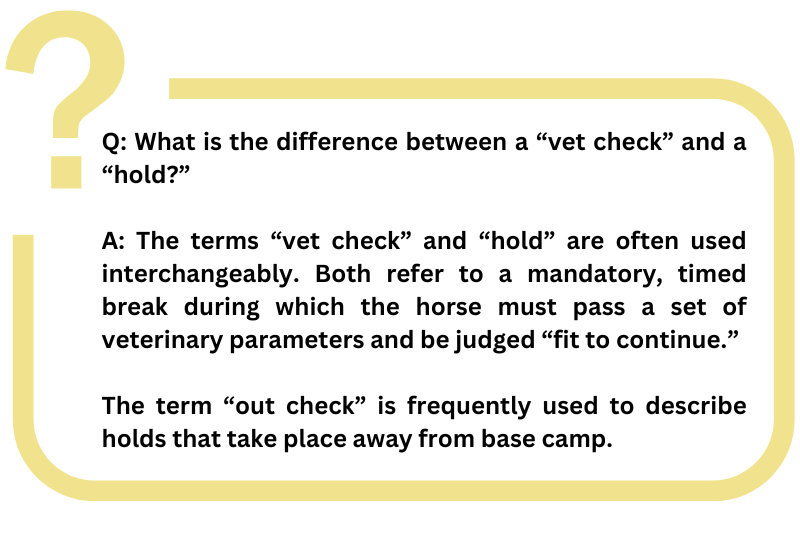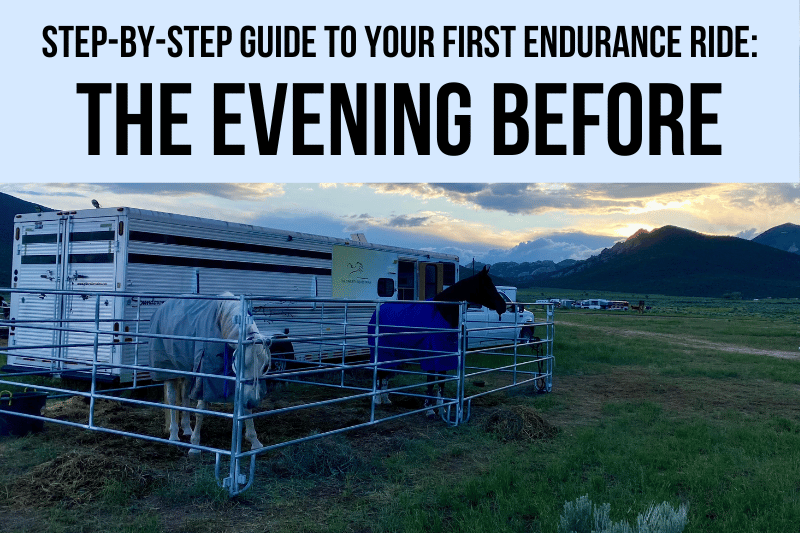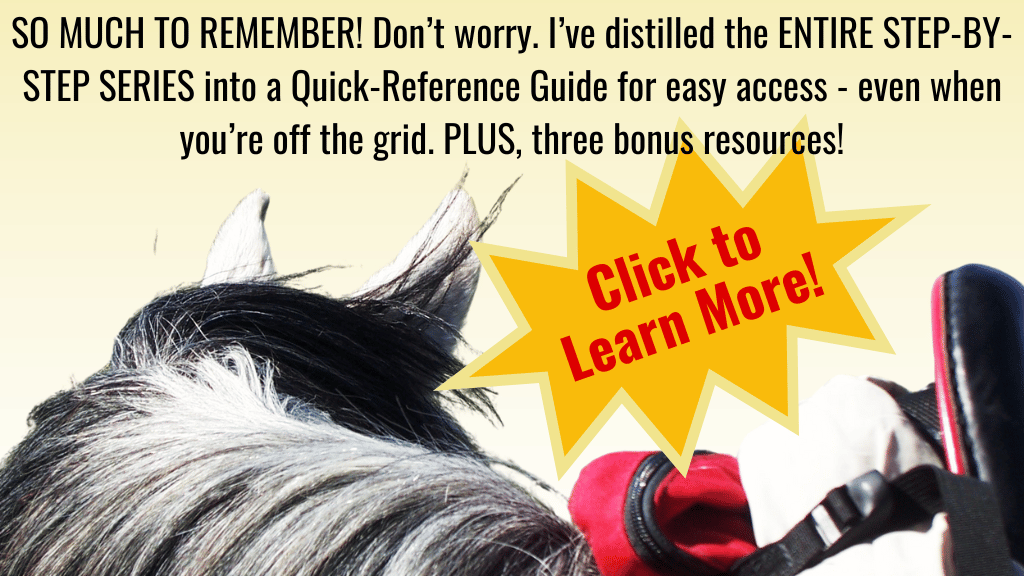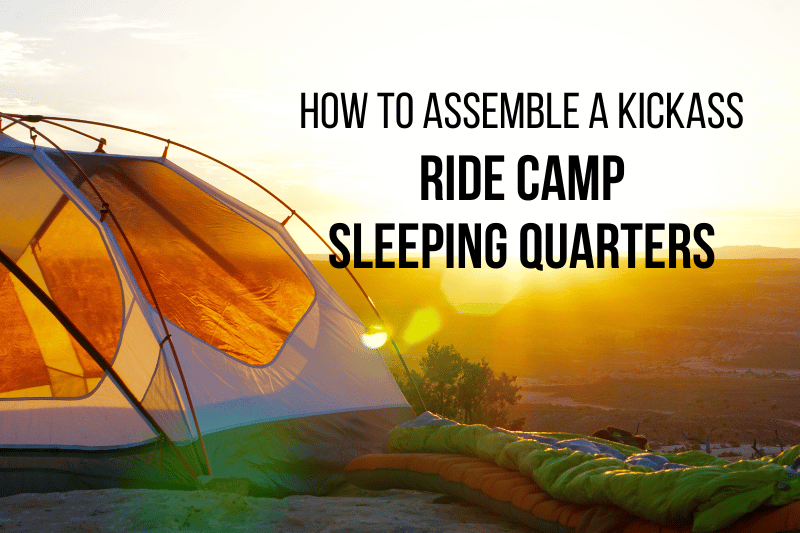The evening before an equestrian endurance ride comes with a long to-do list. This article will walk you through vetting your horse, preparing yourself and your horse for morning, and getting the most out of the pre-ride meeting.
Did you catch the earlier posts in this series?
Complete a Pre-Ride Vet Check
At some point in the afternoon or evening before the ride, you’ll notice a line of horses and riders forming at the vetting area. Everyone who will be riding the next day needs to bring their horse over for a brief exam.
Preparing for Pre-Ride Vetting
All you need to take with you to the vet is your ride card and your horse. He must be untacked, and it’s wise (though not required) to have your hoof protection in place in case there are rocks in the trot-out lane.
If you’ll be riding with a ribbon in your horse’s tail (yellow for a stallion, red for a kicker, and sometimes green for a green horse), go ahead and add that as well. The purpose of such ribbons is to give other riders a heads-up about your horse. Since the vetting process will put you into close proximity with other teams, it makes sense to add any ribbons now.
If your horse has been standing still for a while, take the long way around to the vet. Do a practice trot or two. This will get your horse loosened up and in the right frame of mind to trot out promptly.
While you wait in line for the vet, be mindful of spacing from other teams. Nobody wants to get caught in a squabble between horses. Keep control of your horse, and move him off to the side for a bit of groundwork if he’s really wound up. The vet will typically be available for several hours, so don’t feel rushed.
Handling Your Horse for Vetting
When it’s your turn, lead your horse over and hand your ride card to the vet or her scribe. Feel free to let them know if you or your horse are new to endurance so they can provide extra guidance.
The vet will examine your horse starting at his head. She’ll check his gums, pinch the skin of his shoulder, slide her hands down his back, and lift his tail to observe anal tone. She’ll also use a stethoscope to check his heart rate and gut sounds on both sides. Throughout this process, the vet will either write scores on your ride card or call them out to her scribe.
All you need to do is keep your horse standing as quietly as possible. As the vet moves around your horse, make sure you are standing on the same side as she is. That way, if your horse should offer to kick, you can pull his head toward you so his butt swings away from the vet.
Next, the vet will ask you to trot your horse straight away and back again. The trot-out will be around 100 feet each direction. The turnaround point may be marked with a cone, or the vet might simply call out when she’s ready for you to turn around. If you’ve been watching other teams ahead of you in line, you’ll know about how far to go.
Hopefully, you’ve trained your horse ahead of time to offer a brisk trot in hand. It’s one of the 8 Skills to Practice Before Ride Day. Trot to the turnaround, stop and walk the U-turn, then trot back. The vet will be watching for soundness and impulsion, just as she will do at every vet check between now and your completion.
That’s it! Collect your card from the vet or scribe and move on out of the way. Be sure to check your ride card, which will hopefully reflect all A’s (like an elementary school report card). If you do see any B’s, take steps to remedy the issue – usually by continuing to encourage plenty of eating and drinking.
If you have questions or concerns, run them past the vet for advice. If possible, it’s best to wait for a lull between horses vetting in to have this extra conversation.
Prepare for Ride Morning
Ride morning can be a bit stressful. It will probably be dark, cold, and/or buzzing with anticipation. You definitely won’t want to be scrambling to find your bridle or deciding what to eat. The more you can prepare ahead of time, the easier morning will be.
Here are some things to take care of the evening before the ride:
- Soak beet pulp (if you use it)
- Pre-measure feed and supplements
- Set out all your tack
- Boot your horse, if needed (in the morning, boots will be much harder to put on if they’re stiff from cold or your horse is squirrely)
- Pack your saddlebags (see What to Pack in Your Saddle Bags for an Endurance Ride)
- Fill your water bottles
- Put your ride card in a zip-top bag to keep it dry in your saddle bag
- Set out your breakfast
- Set out all your clothes
- Set an alarm
Make a Remember-Me Box
The Remember-Me Box is a trick I use to make sure I remember everything I need to put in or on myself in the morning. Not only does it ensure that I don’t head into the day without something important, but it also helps me stop running lists in my head all night.
For additional tips on chilling our overnight, check out How to Get Better Sleep in Ride Camp.
My Remember-Me Box includes things like:
- Goldbond powder (to go in socks)
- Body Glide (for areas that tend to rub over the miles)
- Desitin (to prevent heat rash on lower legs)
- Deodorant (you’re welcome)
- Electrolyte capsules
- Sunscreen
- Sunglasses (These are easy to forget in the morning twilight, but you’ll want them when the sun comes up. I like the kind with transition lenses so I can put them on while it’s still dark.)
- Helmet
- Eventing vest
My rule is that I need to use everything in the Remember-Me Box before hitting the trail.
Pack a Crew Bag
You won’t necessarily need a crew bag at every ride, but there are several situations in which you will want one:
- Any of the vet checks are out of camp;
- All vet checks are in camp, but you don’t want to hike all the way from the vetting area to your trailer; or
- You ride with a buddy and need to be at his trailer during holds so the horses can stay together.
A well-stocked crew bag will contain everything you need to care for yourself and your horse during a vet check. For details, read my post on How to Pack a Crew Bag for an Endurance Ride.
If there is an out-check, management will tell you during the ride meeting where to put your crew bag so volunteers can haul it there for you in the morning while you ride.

Attend the Pre-Ride Meeting
The pre-ride meeting will typically take place in the evening, somewhere in the vicinity of the registration and vetting areas. You’ll notice people migrating in that general direction, and management may honk a truck horn as the meeting time approaches.
Leave your horse at your trailer. Instead, take along:
- Your camp chair
- A jacket, as ride meetings are often held just as the sun is going down
- A pen and paper or your phone to take notes
- The trail map, if you received one at registration
You will not need your ride card; leave that safely in your saddlebag so it doesn’t get left behind in the morning.
It can sometimes be a little hard to hear, so I recommend settling in close to the front of the group. Don’t be shy. New riders are typically welcomed with great enthusiasm.
What to Listen For During the Pre-Ride Meeting
The ride manager will provide a rundown of important information for the next day. Since there are usually at least two events (like a 25-mile LD and an 50-mile endurance ride) running concurrently, make sure you’re paying attention to the information that applies to you.
Trail Description – The manager will give an overview of the loops. Hone in on the length of each loop and how it is marked.
The markings will typically be surveyor ribbon of a particular color. The standard trail marking method is to keep ribbons on the right (so you can tell if you’re going the correct direction) and signal a turn with three ribbons grouped together.
The manager will tell you whether each loop comes back to camp or leads to a vet check at a different location. She may also cover any potential hazards, landmarks, and water stops for the horses.
Don’t worry; there’s no need to memorize all the details. Focus on this critical information:
- Ribbon color for each loop
- Length of each loop
- Order of the loops
Management may have a sign or map posted with this information. If so, take a photo of it for reference on the trail. If not, just jot a few notes like “Loop 1 – 16 miles – pink” and “Loop 2 – 14 miles – green.”
Holds – Also listen carefully for information about hold times, which typically vary from around 30 minutes to an hour.
The vet will determine hold times based on factors like loop length and weather. Holds early in the ride or following short loops are typically brief. Chilly weather may also lead to shorter hold times so horses are less likely to cramp up.
Limited Distance rides typically have 1 or 2 holds, and 50-mile rides typically have 2 or 3 holds. If your ride has multiple holds, they may be different lengths. They may also be at different locations.
Pulse Criteria – Finally, make note of the pulse criteria that will be used. This criteria is left to the discretion of the vet, and is typically about 60 beats per minute. That’s the heart rate your horse needs to achieve in order to be considered “down” upon arrival at a hold. The clock on your hold time won’t start until your horse’s pulse is down to criteria. If he takes too long to get there, he’ll be pulled from the event.
A later post in series, Handling the Hold, includes tips for reaching pulse criteria.
Questions – The ride manager will open the floor for questions, so don’t hesitate to ask if you need clarification. You can also approach the manager or vet one-on-one after the meeting.
Additionally, many ride managers offer a special orientation meeting for new riders following the regular ride meeting.
Too much information? You need the Quick-Reference Guide!
Just download it to your phone and use the clickable Table of Contents for speedy access to the information you need, when you need it. Click to learn more!
Care for Your Horse
As the evening winds down, pay extra attention to your horse’s wellbeing:
Take him for a walk – This will help keep his muscles loose, especially if he’s not accustomed to the confines of a small pen or high-tie.
Feed him dinner – Remember to skip any of his usual supplements that contain substances banned during competition. Bob Rogers, DVM, recommends skipping added fats because they slow gut motility. They also increase satiety, which isn’t ideal at this moment when you want your horse to consume as much forage as possible.
Avoid banned treatments – Bear in mind that you can’t use any injectables or treatments like magnets or kinetic tape once your horse passes his pre-ride vet check. If you want to spoil him, stick to carrot stretches and manual massage. (See AERC’s full list of banned treatments in Appendix F here.)
Electrolyte (or not) – Just as with electrolyting up on arrival in camp, the question of whether to electrolyte the evening before the ride is a matter of debate. The goal is to top up the body’s stores after any losses that occurred during travel, as well as to encourage drinking. However, another common opinion is that electrolyting horses that don’t need it just makes expensive pee.
Personally, I usually administer a half-dose of electrolytes with dinner if I didn’t already do so upon arrival in camp. I top-dress it on a handful of low-starch feed mixed with a gut-supporting supplement like Mad Barn’s Visceral+.
Another option is to offer your horse two buckets of water – one plain, and the other laced with electrolytes – and let him choose.
Consider Blanketing – Depending on the weather, you will likely see many riders blanketing their horses before bed. Even if you rarely blanket at home, consider doing so in camp because your horse won’t have the option of moving around freely or getting under shelter. You want him to be comfortable and relaxed overnight, not braced against the chill.
Care for Yourself
Don’t get so busy taking care of your horse that you forget to take care of yourself. You’ll have a long day tomorrow, too!
Eat a meal that’s likely to sit well on your stomach. Drink some water. Go easy on the alcohol.
If you’re feeling anxious, sit still for a moment and try to identify exactly what is nagging at you:
Are you worried you’ll forget something in the morning? Put it in your Remember-Me Box!
Do you think you’ll forget which ribbons to follow? Put your notes with your ride card on your saddle.
Are you nervous about how your horse will behave? Visualize the potential situation and how you’ll handle it with confidence. Know that you can always dismount if things get dicey.
Finally, take a deep breath and remember that endurance riding is a recreational activity. It’s a game! If you don’t finish on time (or at all), that’s perfectly okay. All that really matters is that you have a fun day that ends with a healthy horse.
You’re going to do great.
Keep reading the rest of the series!
Part 4: Step-By-Step Guide: Starting the Ride
Part 5: Step-By-Step Guide: Handling the Hold
Part 6: Step-By-Step Guide: Finishing the Ride
Have you subscribed to my newsletter? Don’t miss out on subscriber-only content. It’s like getting an extra two blog posts every month, straight to your inbox!
You might also like
This post includes affiliate links, and I may earn a small commission (at no extra cost to you) when you purchase through these links. I only recommend products and services I think are helpful and useful. Thanks for helping me offset the cost of maintaining this blog as a free resource!





I love the ‘Remember Me’ box idea!
It keeps me sane!